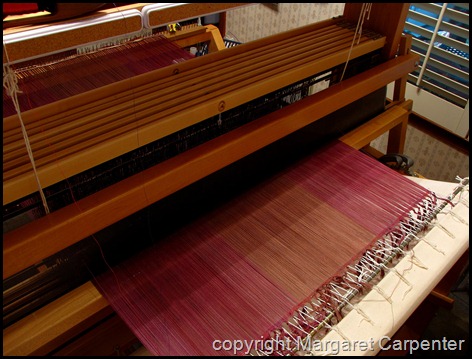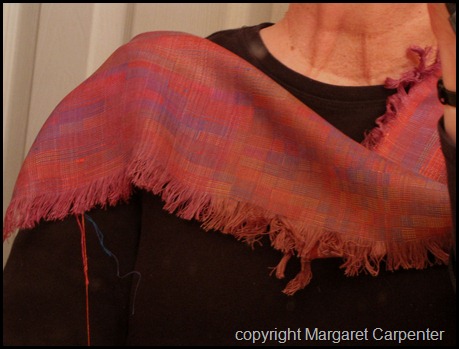Before I started winding bobbins I decided I needed to do just a bit more testing of this warp. I wove two blocks. Whoops.
PROBLEM ONE
I learned that I cannot do the kind of treadling with six blocks that I had intended. When I get to using treadles five and six as the pattern treadles, I cannot use the same pattern of treadles for the binders that I used on the first four pattern treadles. What I will do is keep the original treadling for the first four blocks and when I start blocks five and six, figure out which treadles will work as the binder treadles.
Why didn’t this show up in the software? Probably I didn’t know what I was looking for.
PROBLEM TWO
There are, yes there are, threading errors! I fussed and fumed for a bit. Well, actually, for quite a bit. Then I began to wonder if there was a way I could correct these errors by either removing heddles or adding repair heddles, depending on what I found when I started investigating.
These threading problems all occur when, and only when, I change blocks. This means that I do not quite understand the process of changing blocks in terms of the threading. It also means that when I check the drawdown for errors in the future on this kind of crackle, I need to watch especially carefully those places between blocks.
THREE THREADING ERRORS
I was glad there were only three!
1. In the case of the first error, the last thread of one block was not on the correct shaft. I added a repair heddle to that shaft, removed the errant warp end and rethreaded it into the repair heddle, sleyed it and pinned it to the woven fabric.Before I made these corrections, by the way, I checked VERY CAREFULLY the drawdown
2. The second error involved simply removing a heddle and removing the warp end. That solution will cause me to have to resley everything from there to the right side of the loom. And I will have to tie on the whole warp. Still, that is not as bad as rethreading!
3. And the third error, like the first, involved adding a repair heddle to another shaft, remove the warp end from the incorrect heddle and thread it through the correct one.
So now I can cut off a small bit of warp on the left side of the loom and a larger bit on the right side and prepare for some re-sleying. Again.







